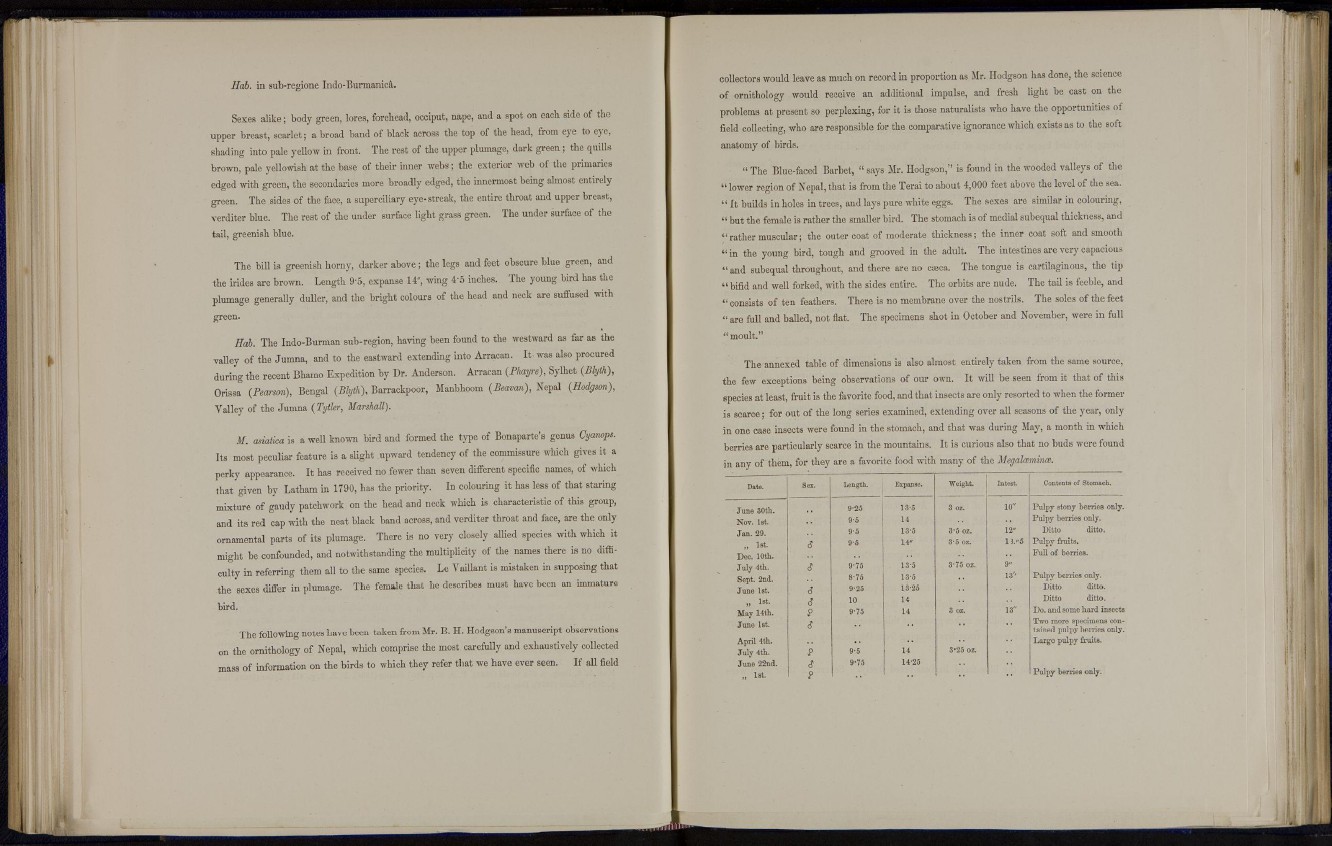
Hob. in sub-regione Indo-Burmanicá.
Sexes alike; body green, lores, forehead, occiput, nape, and a spot on each side of the
upper breast, scarlet; a broad band of black across the top of the head, from eye to eye,
shading into pale yellow in front. The rest of the upper plumage, dark green ; the quills
brown, pale yellowish at the base of their inner webs; the exterior web of the primaries
edged with green, the secondaries more broadly edged, the innermost being almost entirely
green. The sides of the face, a superciliary eye-streak, the entire throat and upper breast,
A-erditer blue. The rest of the under surface light grass green. The under surface of the
tail, greenish blue.
The bill is greenish horny, darker above; the legs and feet obscure blue green, and
the irides are brown. Length 9-5, expanse 14", wing 4'5 inches. The young bird has the
plumage generally duller, and the bright colours of the head and neck are suffused with
green.
Hob. The Indo-Burman sub-region, having been found to the westward as far as the
valley of the Jumna, and to the eastward extending into Arracan. It was also procured
during the recent Bhamo Expedition by Dr. Anderson. Arracan (Phayre), Sylhet (Blyth),
Orissa (Pearson), Bengal (Blyth), Barrackpoor, Manbhoom (Beavan), Nepal (Hodgson),
Valley of the Jumna (Tytler, Marshall).
M. asiática is a well known bird and formed the type of Bonaparte's genus Cyanops.
I t s most peculiar feature is a slight upward tendency of the commissure which gives i t a
perky appearance. It has received no fewer than seven different specific names, of which
that given by Latham in 1790, has the priority. In colouring it has less of that staring
mixture of gaudy patchwork on the head and neck which is characteristic of this group,
and its red cap with the neat black band across, and verditer throat and face, are the only
ornamental parts of its plumage. There is no very closely allied species with which it
might be confounded, and notwithstanding the multiplicity of the names there is no difficulty
in referring them all t o the same species. Le Vaillant is mistaken in supposing that
t h e sexes differ in plumage. The female that he describes must have been an immature
bird.
The following notes have been taken from Mr. B. H. Hodgson's manuscript observations
on the ornithology of Nepal, which comprise the most carefully and exhaustively collected
mass of information on the birds t o which they refer that we have ever seen. If all field
collectors would leave as much on record in proportion as Mr. Hodgson has done, the science
of ornithology wotdd receive an additional impulse, and fresh light be cast on the
problems at present so perplexing, for it is those naturalists who have the opportunities of
field collecting, who are responsible for the comparative ignorance which exists as to the soft
anatomy of birds.
" The Blue-faced Barbet, " says Mr. Hodgson," is found in the wooded valleys of the
" lower region of Nepal, t h a t is from the Terai to about 4,000 feet above the level of the sea.
" It builds in holes in trees, and lays pure white eggs. The sexes are similar in colouring,
" but the female is rather the smaller bird. The stomach is of medial subcqual thickness, and
" r a t h e r muscular; the outer coat of moderate thickness; the inner coat soft and smooth
" in the young bird, tough and grooved in the adult. The intestines a r e very capacious
" and subcqual throughout, and there are no cajca. The tongue is cartilaginous, the tip
" bifid and well forked, with the sides entire. The orbits are nude. The tail is feeble, and
" consists of ten feathers. There is no membrane over the nostrils. The soles of the feet
" are full and balled, not flat. The specimens shot in October and November, were in full
" m o u l t ."
The annexed table of dimensions is also almost entirely taken from the same source,
the few exceptions being observations of our own. It will be seen from it that of this
species at least, fruit is the favorite food, and that insects are only resorted to when the former
is scarce; for out of the long series examined, extending over all seasons of the year, only
in one case insects were found in the stomach, and that was during May, a month in which
berries are particularly scarce i n the mountains. It is curious also t h a t no buds were found
in any of them, for they are a favorite food with many of the Megalanninee.
Date. Sex. Length. Expanse. Weight. Intest. Contents of Stomach.
June 30th. 9-25 135 3 oz. 10" Pulpy stony berries only.
Nov. 1st. 9 5 14 Pulpy berries only.
Jan. 29. 9 5 13-5 3-5 oz. 12" Ditto ditto.
„ 1st. s 9-5 14" 3-5 oz. l i . «5 Pulpy fruits.
Dec. 10th. Full of berries.
July 4th. i 9-75 13-5 3-75 oz. 9"
Sept. 2nd. 8-75 13-5 13'' Pulpy berries only.
June 1st. 6 9-25 13-25 Ditto ditto.
„ 1st. 3 10 14 Ditto ditto.
May 14th. $ 9-75 14 3 oz. 13" Do. and some hard insects
Juno 1st. <¡ Two more specimens contained
pulpy berries only.
April 4th. Largo pulpy fruits.
July 4th. 9 9-5 14 3-25 oz.
June 22nd. a 9-75 14-25
» l 8 t -
Pulpy berries only.